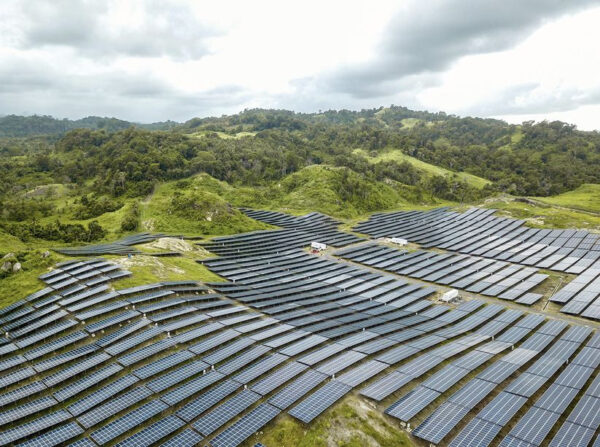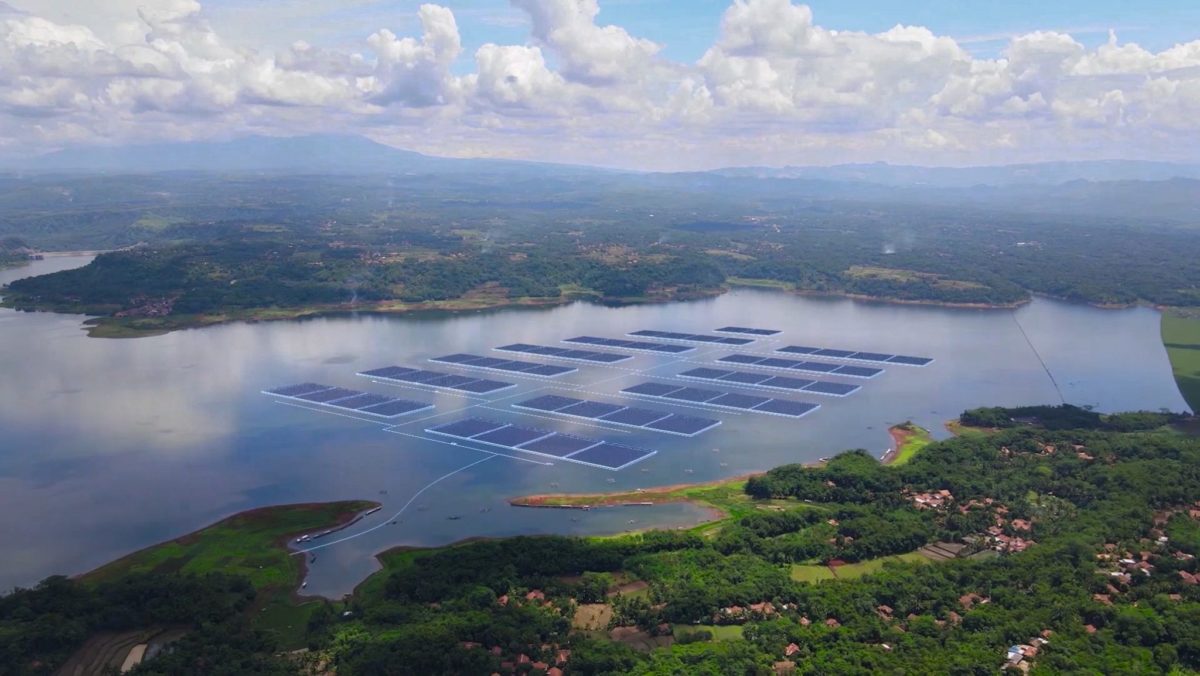From pv magazine ISSUE 03-2023
Indonesian state-owned utility Perusahaan Listrik Negara (PLN) wants 2.4 GW of floating solar generation capacity in 2025, under its 10-year business plan.
A report published by the Institute for Essential Services Reform (IESR) in November 2021 stated that PLN is constructing a 145 MW (AC) site at the Cirata Dam and a 60 MW (AC) project at the Saguling Dam, both in West Java, plus a 90 MW(AC) facility at Singkarak Lake, in West Sumatra.
The Cirata Floating Solar PV project is being developed by UAE-state-owned Masdar Energy and PLN subsidiary PT Pembangkitan Jawa Bali Investasi. The Ministry of Energy and Mineral Resources tells pv magazine – via its Directorate-General of New Renewable Energy and Energy Conservation – that Cirata was “36.38%” complete in December 2022, although it had been slated for completion that year. The ministry says domestic content requirements for the solar modules have hampered financial feasibility and the rough condition of the reservoir bed has complicated installation of the anchoring system.
The floating projects in Saguling and Singkarak are being developed by PLN unit PT Indonesia Power and 50%-state-owned Saudi developer ACWA Power which, in October 2020, offered to generate power for 30% less than the PLN tariff of $0.058/kWh, coming in at $0.041. “We saw the great potential of the country and its commitment to renewable energy and net-zero emission targets,” said Salman Baray, country director of ACWA Power Indonesia. “We are working very closely with the biggest government utility company in Indonesia, PLN, to support their requirements.”
Baray also cited the problems caused by having to source solar panels with sufficient Indonesian content. “A major challenge we are dealing with is meeting high local content requirements in place for solar – this is something all solar developers are facing and struggling to overcome,” Baray said. “In fact, it is almost impossible, at this stage, to meet the requirements for utility-scale projects and we hope that things improve greatly in this area.”
Made in Indonesia
Local content requirements are established by regulations 4/2017 and 5/2017, issued by the Ministry of Industry. The rules require 34% to 40% of equipment – including solar modules, inverters, and mounting structures – to come from Indonesian industry. All project services – such as logistics, installation, and construction – must be provided by Indonesian companies.
Regarding panel content, 60% is required to have come from Indonesian manufacturers. The plan is for the requirement to hit 90% by 2025, underpinned by local polysilicon, ingot, and metallurgical-grade silicon production, according to the IESR’s “Solar Energy Outlook 2023.” There appears zero chance of that happening, with the IESR stating the lack of Indonesian cell manufacturing means module assemblers can reach only 47.5% local content. Projects have fallen short of the regulatory requirement as a result.
Data released by the energy ministry in 2022 listed 21 Indonesian solar panel assemblers with a total annual production capacity of 1.6 GW. Module components including tempered glass, EVA film, and PV ribbons cannot be produced domestically.
No Indonesian solar manufacturer has reached 100 MW of annual production capacity. “If we need 150 MW of solar modules, no company can sell us that capacity,” said Baray. “We will need to buy it from at least two to three manufacturers, which will create all sorts of challenges including difficulty in getting financing. The other challenge is also the use of older technology, with a price that is almost 20% to 30% higher than, say, the cost of panels from China.”
The lack of big solar companies has caused project bankability problems. The loans typically used by developers require companies to work with modules from tier-1 manufacturers. Tier 1 is interpreted as having supplied products to at least six projects in two years and having secured non-recourse finance from six commercial banks during the same period. Indonesian solar companies have been unable to reach that standard.
Bankability fears
The lack of big solar companies has caused project bankability problems. The loans typically used by developers require companies to work with modules from tier-1 manufacturers. Tier 1 is interpreted as having supplied products to at least six projects in two years and having secured non-recourse finance from six commercial banks during the same period. Indonesian solar companies have been unable to reach that standard.
The IESR says the government must show flexibility on local content. “Indonesia has defined its green ambitions and is working toward it,” agrees Baray. “However, current restrictions will likely hinder achieving its goals. We need to develop local industries by creating enough demand, which will allow the local manufacturers to expand and take advantage of economies of scale.”
PLN has not responded to repeated interview requests from pv magazine.

Image: Ministry of Energy and Mineral Resources (MEMR) of the Republic of Indonesia
Other projects
The IESR’s 2021 report stated steelmaker PT Krakatau Steel is constructing a 12.5 MW (AC) project at the Krenceng Dam, in Cilegon, West Java, alongside renewables developer PT Akuo Energy. Aluminum smelter PT Inalum and coal miner PT Bukit Asam are developing 770 kW (AC) of FPV sites on the Sigura-Gura Dam in North Sumatra.
Those sites would be dwarfed by the project being installed by Badan Pengusahaan Batam, the government agency for the free port area of Batam. The installation, on the Duriangkang Dam near Batam City, was reported by the IESR, in 2021, as a 1.7 GW/4 GWh FPV and battery storage plant to be jointly developed by Singapore-based Sunseap. The energy ministry, however, recently announced the project partner will now be the PT Batam Sarana Surya subsidiary of coal miner PT Adaro Energy Indonesia. The facility is now being described as a 1 GW floating solar plant.
The directorate-general for renewables tells pv magazine that PLN’s PT PLN Batam unit will take 20% of the power produced at the site, with the rest to be exported to Singapore. No commercial operation date has been set because the developers are waiting to learn, from the Ministry of Public Works and Housing, how much of the reservoir’s surface can host FPV. Regulations state a maximum 5% of the surface area of dams, lakes, and reservoirs can be covered but Batam Sarana Surya wants to cover 42% of the Duriangkang Dam. Government permits will also be needed for development in a forested area.
Other FPV sites are being driven by corporate sustainability policies, according to the IESR Solar Analyst Daniel Kurniawan. He tells pv magazine that “the biggest reason for the growing initiative from industries and businesses is their sustainability goals and the pressure to lower their CO2 emissions. This was also good for the companies to achieve their sustainability targets and, at the same time, to reduce electricity costs. For the corporates, they also do not need to comply with the local content requirement of the PV panels if they are not selling their electricity to PLN.”
G20 windfall
Jakarta secured a deal at the G20 summit held in Bali in November 2022 that will see the governments of the US, Japan, Canada, Denmark, France, Germany, Italy, Norway, and the UK – plus the EU – provide $10 billion of cheap loans, grants, and equity investment to help wean Indonesia off coal. The US said private financial institutions would supply another $10 billion as part of the $20 billion Just Energy Transition Program.
In return, Jakarta promised power-sector emissions will start to fall this decade and the nation’s power will be emissions-free by 2050. Ministers are working on a renewables strategy.
Energy exports
The situation regarding clean energy exports remains unclear, according to the IESR, which stated the government has yet to issue any permits despite at least five developers eyeing export-oriented solar projects in the Riau Islands. Those developers had responded to a call made by Singapore in October 2021 for the supply of “low-carbon electricity” from 4 GW of generation capacity, but Indonesian President Joko Widodo reportedly wants a ban on green power exports over fears about missing domestic emissions-reduction targets. Clean power exports are permitted provided local demand has been satisfied, the exported energy is not subsidized, and the quality and reliability of electricity is not adversely affected. However, Jakarta has yet to issue any permits, according to the IESR.
While the nation currently generates an electricity surplus, it comes from coal-fired power plants, severely restricting the market for foreign buyers. With neighboring Malaysia already exporting clean power, decades-old talks about connecting the electricity grids of the 10 countries in the Association of Southeast Asian Nations (ASEAN) have gained renewed prominence.
“The governments are really seriously thinking about how to clean their power system – especially when the power demands in Southeast Asia are expected to grow rapidly,” said Caroline Chua, a BloombergNEF analyst in Singapore. “Many are looking for an alternative to coal-fired power plants.”
The challenge, said Chua, is that the ASEAN grids require a lot of harmonization in terms of policies, regulations, and market operations, once the grids are connected to each other. “ASEAN is fragmented geographically, unlike Europe,” she said. “This raises questions about the financing of infrastructure, how they are going to bring power markets together, and, of course, about energy security to ensure reliable supply.”
BloombergNEF notes pilot projects toward a unified grid network are taking place in Thailand, Laos, Malaysia, Vietnam, and Singapore, and there are already cross-border interconnections between some power markets. Singapore has been actively attempting to procure clean power imports to help it towards its climate goals.
“This example shows how a country in the Southeast Asian region can help drive renewables development in another country,” added Chua. “The technology for cross-border power trading exists. Still, when it comes to financing, it can be quite tricky, especially in Southeast Asian countries where the power market is still highly regulated.”
This content is protected by copyright and may not be reused. If you want to cooperate with us and would like to reuse some of our content, please contact: editors@pv-magazine.com.








1 comment
By submitting this form you agree to pv magazine using your data for the purposes of publishing your comment.
Your personal data will only be disclosed or otherwise transmitted to third parties for the purposes of spam filtering or if this is necessary for technical maintenance of the website. Any other transfer to third parties will not take place unless this is justified on the basis of applicable data protection regulations or if pv magazine is legally obliged to do so.
You may revoke this consent at any time with effect for the future, in which case your personal data will be deleted immediately. Otherwise, your data will be deleted if pv magazine has processed your request or the purpose of data storage is fulfilled.
Further information on data privacy can be found in our Data Protection Policy.